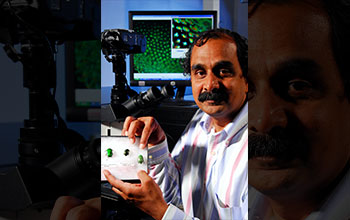Multimedia Gallery
Professor Mohan Srinivasarao and jeweled beetle
Professor Mohan Srinivasarao points to a jeweled beetle (Chrysina gloriosa), the subject of his research on surface structures
More About This Image
Mohan Srinivasarao, a professor at the School of Polymer, Textile and Fiber Engineering at Georgia Tech, received a grant from the National Science Foundation (NSF) to study what gives the jeweled beetle's shell its iridescence. It is the interaction of light with physical structures on their external surfaces that gives creatures like iridescent beetles, butterflies, certain sea organisms and many birds their unique colors.
Srinivasarao worked with colleagues Vivek Sharma, Matija Crne and Jung Ok Park to study the surface structures on the shells. The team published a detailed analysis in Science magazine of how the jeweled beetle Chrysina gloriosa uses a helical structure that reflects light of two specific colors, and of only one polarization--left circular polarization, to create their striking colors. The reflecting structures used by the beetle consist predominately of three different polygonal shapes--hexagons, pentagons and heptagons, each less than 10 microns in size--whose percentages vary with the curvature of the insect's shell.
"This is really a pattern formation issue," said Srinivasarao. "It is difficult to pack only hexagons onto a curved surface. On flat surfaces, there are fewer defects in the form of five- and seven-sided cells."
Srinivasarao believes the patterns are due to the nature of the cholesteric liquid crystal and because the liquid crystal phase structures itself at the interface between air and fluid. "We think these patterns result because the liquid crystal must have defects on the surface when exposed to air, and those defects create the patterns in the beetle's shell or exoskeleton," says Srinivasarao.
Studying these shimmery shells may lead to new insights into liquid crystal technology. "Understanding how these structures give rise to the stunning colors we see in nature could benefit the quest for miniature optical devices and photonics," said Srinivasarao. Liquid crystalline materials have many uses, from displays for laptop computers to portable music players and other devices to children's thermometers.
Learn more in the NSF news release What scientists know about jewel beetle shimmer. [Research supported by NSF grant DMR 07-06235.] (Date of Image: July 2009)
Credit: Georgia Tech; photo by Gary Meek
Images and other media in the National Science Foundation Multimedia Gallery are available for use in print and electronic material by NSF employees, members of the media, university staff, teachers and the general public. All media in the gallery are intended for personal, educational and nonprofit/non-commercial use only.
Images credited to the National Science Foundation, a federal agency, are in the public domain. The images were created by employees of the United States Government as part of their official duties or prepared by contractors as "works for hire" for NSF. You may freely use NSF-credited images and, at your discretion, credit NSF with a "Courtesy: National Science Foundation" notation.
Additional information about general usage can be found in Conditions.
Also Available:
Download the high-resolution JPG version of the image. (5.8 MB)
Use your mouse to right-click (Mac users may need to Ctrl-click) the link above and choose the option that will save the file or target to your computer.

 All images in this series
All images in this series